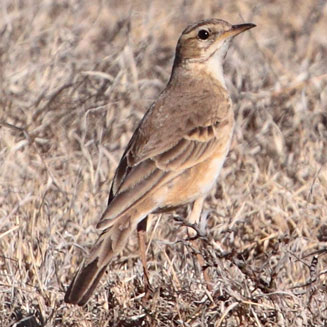|
Anthus longicaudatus
(Long-tailed pipit)
Langstertkoester [Afrikaans]; Pipit à longue queue
[French]
Life
> Eukaryotes >
Opisthokonta
> Metazoa (animals) >
Bilateria >
Deuterostomia > Chordata >
Craniata > Vertebrata (vertebrates) > Gnathostomata (jawed
vertebrates) > Teleostomi (teleost fish) > Osteichthyes (bony fish) > Class:
Sarcopterygii (lobe-finned
fish) > Stegocephalia (terrestrial
vertebrates) > Tetrapoda
(four-legged vertebrates) > Reptiliomorpha > Amniota >
Reptilia (reptiles) >
Romeriida > Diapsida > Archosauromorpha > Archosauria >
Dinosauria
(dinosaurs) > Saurischia > Theropoda (bipedal predatory dinosaurs) >
Coelurosauria > Maniraptora > Aves
(birds) > Order: Passeriformes
> Family: Motacillidae > Genus: Anthus
 |
|
|
Long-tailed pipit, Hope Christiana, South Africa. [photo
Adam Riley ©, Rockjumper Tours] |
|
Distribution and habitat
Very little is known about this species as it has only
recently been described, but it is thought to breed in north-western Zambia and
adjacent Angola and southern DRC, heading south in the non-breeding season to
the area around Kimberley in the Northern Cape, where it was first described. It
generally prefers short grassland, either natural or man-made, such as in urban
parks and ploughed fields.
Movements and migrations
It is likely to be an intra-African breeding
migrant to South Africa, mainly staying from May-August, with peak
numbers in later July and early August.
Food
Diet unknown, however it has been observed foraging on the
ground, with its body in a horizontal stance.
References
-
Hockey PAR, Dean WRJ and Ryan PG 2005. Roberts
- Birds of southern Africa, VIIth ed. The Trustees of the John Voelcker
Bird Book Fund, Cape Town.
|
